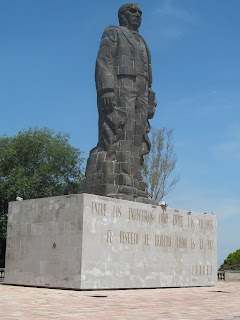It’s a
very odd morning. Jeanne is not feeling
well and has stayed home from school, so I’m sneaking around so as not to
disturb her. It’s not clear, however,
why any noise I could make would wake her (and certainly she slept through my
washing the dishes), since she has not responded to the noise outside. Across the street from us a workman with
execrable taste in music is fixing the roof; the dogs are barking, too, for no
more apparent reason than usual, but I don’t let it bother me.
It reminds me of the story told to us by our
friend Judith, who lives high on the hill near where we stayed last time we
were here, with a stunning view of the town.
An American rents an apartment in San Miguel, but after a week he calls
his Mexican landlady and tells her that he simply can’t stay there. He loves everything about the apartment, the
neighborhood, the location, but he can’t stand the incessant noise, especially
the barking dogs. “Then why do you
listen to them?” she asks.
The sun
is sneaking around too: that’s the other odd thing about the morning. When I got up and brought my coffee out here,
it seemed like another beautiful day was planned. The town usually has clear skies above us as
soon as he sun starts to do his job (suns being masculine according to standard
Jungian theory), while the hills all around us have a tonsure of clouds above
them. We are on the eastern edge, with
the hill essentially starting at our doorstep, but we have a long view across
to the sunset hills, which are often covered in a haze, as they still are
now. On our side, however, the clouds
suddenly cascaded over the hills in a thick mist such as one sees all the time
in the English Lake District. The grand houses on the hill disappeared, and
all those domes and towers showing in our first blog acquired a neutral
background, the green hill behind them no longer existing. An hour later, all the fog has disappeared.
We are
surrounded not only by hills, but by history, for this area, the states of
Guanajuato and Querétaro, are the landmarks of Mexican independence and
democracy. The USA had to deal only nice
people like the British, but the Mexicans suffered greatly under the Hapsburgs,
who brought them the gifts of elegance and military arrogance, and, especially,
the Spanish, who brought them the gift of militant and gory Catholicism. Some of it this history is reflected in place
names: our own San Miguel de Allende and the nearby Dolores Hidalgo. The city of Querétaro, which we visited last
weekend, is a major focus of this activity, and our guide was obviously proud
to highlight it for us. During the
uprisings and the back and forth of the struggle it served briefly as the
capital of Mexico, and the constitution was signed there.
The city
itself is sprawling and modern, and attracts people from all over Mexico to
work in its factories, but the historic center is preserved and charming, with
several lovely plazas lined with
trees and fountains. On our way in, we
stopped at the famous Los Arcos, a massive aqueduct built in the early 18th
century and still in use, much larger, if much younger, than the Roman one in Segovia. A nearby mausoleum houses the remains of La
Corregidora, heroine of the uprising of 1810, as well as those of her husband,
the former governor of the region. We
went on to the Cerro de las Campañas, so-called because the rocks, when struck,
sound like bells. Here, poor Emperor
Maximilian’s lavish exploitation of the people came to a timely end. The Hapsburgs erected what I think is a puny
little chapel as a memorial; but it is dwarfed by a colossal statue of Benito
Juarez, Mexico’s first president after final independence in 1910. Power to the people ‘n’ all that.
The rest
of the afternoon was spent in lunch (that delicious huitlacoche!) and visiting some of the lovelier baroque buildings
(churches, museums, former private houses).
By that time, this old geezer was ready for home, but enjoyed the trip
back through the fertile agricultural zone.
We later discovered that the area produces several well-considered
wines. We have a bottle of the red which
we haven’t opened yet, but we love the semi-sweet white which we are using as a
cocktail and are thinking of bringing back with us.
How can
you not love a place where you can get unheralded wines, huitlacoche, and a fifth of Evan Williams for eleven bucks?



No comments:
Post a Comment